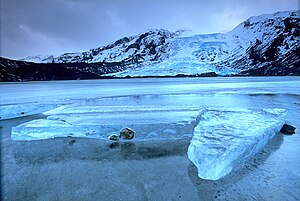
Back بوابة:آيسلندا Arabic Portal:İslandiya Azerbaijani دەروازە:ئایسلەند CKB Portál:Island Czech Portal:Island German Portal:Islandia Spanish Atari:Islandia Basque Portail:Islande French Portal:Islandia Galician Պորտալ:Իսլանդիա Armenian
The Iceland Portal
Iceland (Icelandic: Ísland, pronounced [ˈistlant] ⓘ) is a Nordic island country between the North Atlantic and Arctic Oceans, on the Mid-Atlantic Ridge between North America and Europe. It is culturally and politically linked with Europe and is the region's westernmost and most sparsely populated country. Its capital and largest city is Reykjavík, which is home to about 36% of the country's roughly 380,000 residents (excluding nearby towns/suburbs, which are separate municipalities). The official language of the country is Icelandic. Iceland is on a rift between tectonic plates, and its geologic activity includes geysers and frequent volcanic eruptions. The interior consists of a volcanic plateau with sand and lava fields, mountains and glaciers, and many glacial rivers flow to the sea through the lowlands. Iceland is warmed by the Gulf Stream and has a temperate climate, despite a latitude just south of the Arctic Circle. Its latitude and marine influence keep summers chilly, and most of its islands have a polar climate. According to the ancient manuscript Landnámabók, the settlement of Iceland began in 874 AD, when the Norwegian chieftain Ingólfr Arnarson became the island's first permanent settler. In the following centuries, Norwegians, and to a lesser extent other Scandinavians, immigrated to Iceland, bringing with them thralls (i.e., slaves or serfs) of Gaelic origin. The island was governed as an independent commonwealth under the native parliament, the Althing, one of the world's oldest functioning legislative assemblies. After a period of civil strife, Iceland acceded to Norwegian rule in the 13th century. In 1397, Iceland followed Norway's integration into the Kalmar Union along with the kingdoms of Denmark and Sweden, coming under de facto Danish rule upon its dissolution in 1523. The Danish kingdom introduced Lutheranism by force in 1550, and the Treaty of Kiel formally ceded Iceland to Denmark in 1814. (Full article...) Selected article -Four ships of the Icelandic Coast Guard have been named ICGV Þór.
Selected picture Eyjafjallajökull is one of the smaller Icelandic glaciers, located north of Skógar and west of the larger glacier Mýrdalsjökull. The ice cap of the glacier covers a volcano, which has erupted relatively frequently since the Ice Age. The last eruption was from 1821 to 1823, causing a fatal glacier run. The crater of the volcano has a diameter of 3-4 km and the glacier covers an area of about 100 km². News
Main topicsSelected biography -Halldór Kiljan Laxness (Icelandic: [ˈhaltour ˈcʰɪljan ˈlaksnɛs] ⓘ; born Halldór Guðjónsson; 23 April 1902 – 8 February 1998) was an Icelandic writer and winner of the 1955 Nobel Prize in Literature. He wrote novels, poetry, newspaper articles, essays, plays, travelogues and short stories. Writers who influenced Laxness include August Strindberg, Sigmund Freud, Knut Hamsun, Sinclair Lewis, Upton Sinclair, Bertolt Brecht, and Ernest Hemingway. (Full article...) Did you know (auto-generated) -

Selected quoteGeneral imagesThe following are images from various Iceland-related articles on Wikipedia.
Selected panorama Hvanneyri is an Icelandic settlement with a population of 303 (as of December 1, 2007).
CategoriesThings you can do
Wikipedia in Icelandic
Recognized content
New articlesThis list was generated from these rules. Questions and feedback are always welcome! The search is being run daily with the most recent ~14 days of results. Note: Some articles may not be relevant to this project.
Rules | Match log | Results page (for watching) | Last updated: 2025-01-11 20:39 (UTC) Note: The list display can now be customized by each user. See List display personalization for details.
Web resources
Associated WikimediaThe following Wikimedia Foundation sister projects provide more on this subject:
SourcesDiscover Wikipedia using portals | |||||||||||























































